Analysing Organisational Conflict: The Porsche-Volkswagen Case Study
VerifiedAdded on 2021/04/16
|6
|1253
|81
Case Study
AI Summary
This case study examines the conflict within the Volkswagen Group, focusing on the clash between Porsche and Volkswagen executives, specifically Karl Frederich and Max Lucas. The conflict stemmed from differing management styles, values, and priorities. Frederich, representing Porsche, prioritized profit and lean production, while Lucas, the VW chairman, emphasized innovation and engineering. The analysis delves into their contrasting conflict-handling styles, with Frederich adopting a compromising approach and Lucas employing accommodating and collaborating strategies. The outcome saw Frederich losing his position and Porsche facing financial difficulties, ultimately leading to VW's complete takeover of Porsche. The case highlights the importance of considering both internal and external factors in business strategy and the significance of balancing profit with innovation and technology in the automotive industry.
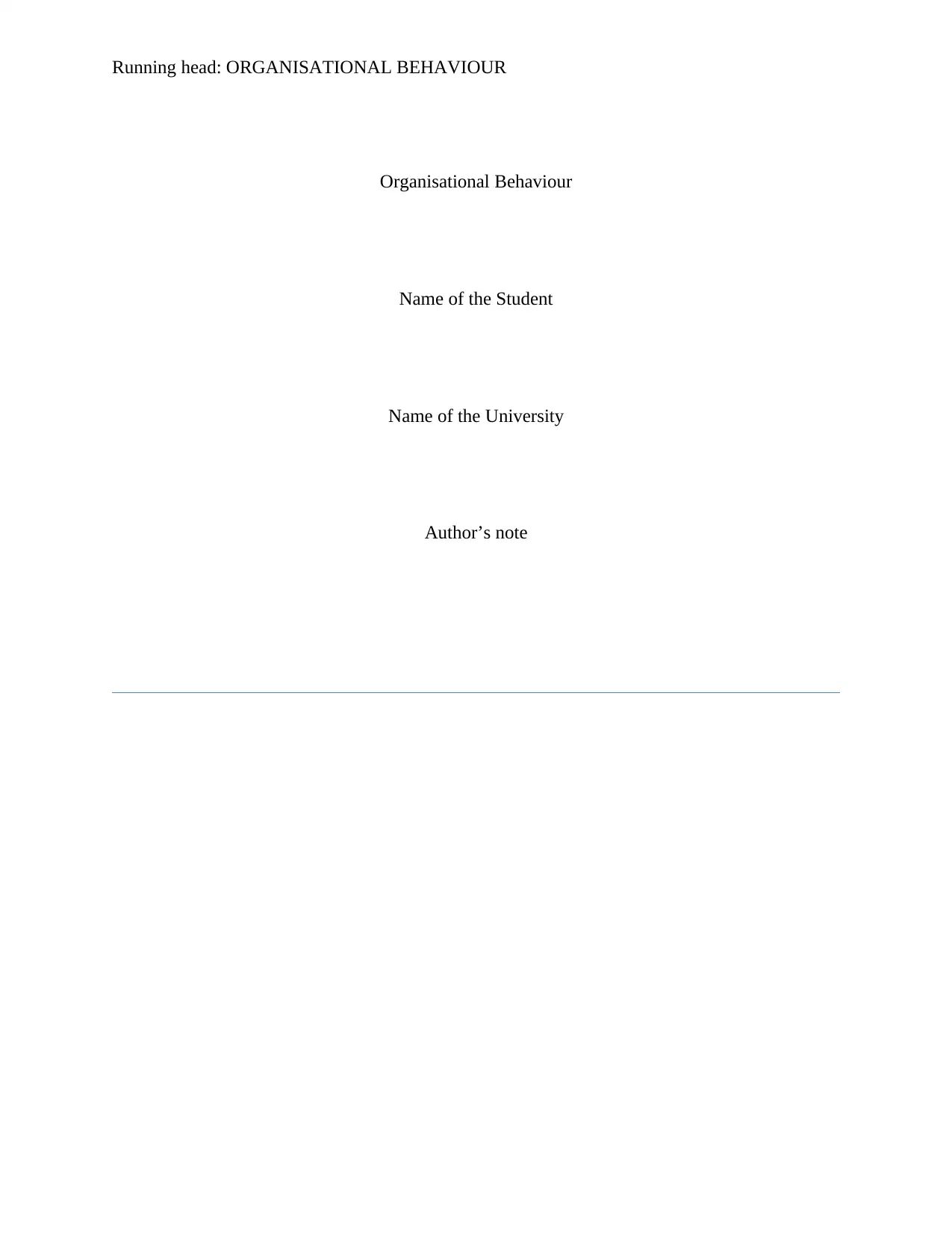
Running head: ORGANISATIONAL BEHAVIOUR
Organisational Behaviour
Name of the Student
Name of the University
Author’s note
Organisational Behaviour
Name of the Student
Name of the University
Author’s note
Paraphrase This Document
Need a fresh take? Get an instant paraphrase of this document with our AI Paraphraser
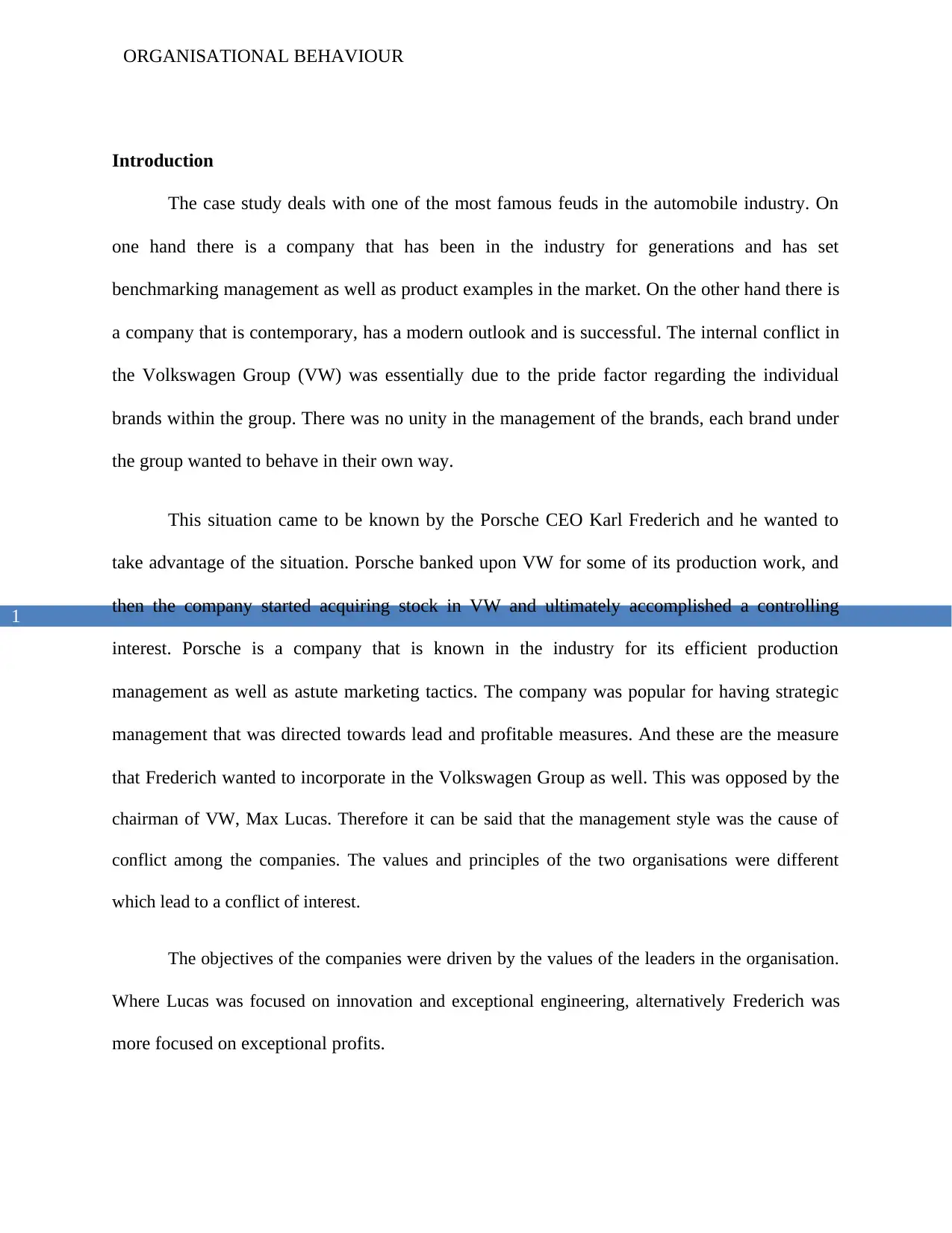
ORGANISATIONAL BEHAVIOUR
1
Introduction
The case study deals with one of the most famous feuds in the automobile industry. On
one hand there is a company that has been in the industry for generations and has set
benchmarking management as well as product examples in the market. On the other hand there is
a company that is contemporary, has a modern outlook and is successful. The internal conflict in
the Volkswagen Group (VW) was essentially due to the pride factor regarding the individual
brands within the group. There was no unity in the management of the brands, each brand under
the group wanted to behave in their own way.
This situation came to be known by the Porsche CEO Karl Frederich and he wanted to
take advantage of the situation. Porsche banked upon VW for some of its production work, and
then the company started acquiring stock in VW and ultimately accomplished a controlling
interest. Porsche is a company that is known in the industry for its efficient production
management as well as astute marketing tactics. The company was popular for having strategic
management that was directed towards lead and profitable measures. And these are the measure
that Frederich wanted to incorporate in the Volkswagen Group as well. This was opposed by the
chairman of VW, Max Lucas. Therefore it can be said that the management style was the cause of
conflict among the companies. The values and principles of the two organisations were different
which lead to a conflict of interest.
The objectives of the companies were driven by the values of the leaders in the organisation.
Where Lucas was focused on innovation and exceptional engineering, alternatively Frederich was
more focused on exceptional profits.
1
Introduction
The case study deals with one of the most famous feuds in the automobile industry. On
one hand there is a company that has been in the industry for generations and has set
benchmarking management as well as product examples in the market. On the other hand there is
a company that is contemporary, has a modern outlook and is successful. The internal conflict in
the Volkswagen Group (VW) was essentially due to the pride factor regarding the individual
brands within the group. There was no unity in the management of the brands, each brand under
the group wanted to behave in their own way.
This situation came to be known by the Porsche CEO Karl Frederich and he wanted to
take advantage of the situation. Porsche banked upon VW for some of its production work, and
then the company started acquiring stock in VW and ultimately accomplished a controlling
interest. Porsche is a company that is known in the industry for its efficient production
management as well as astute marketing tactics. The company was popular for having strategic
management that was directed towards lead and profitable measures. And these are the measure
that Frederich wanted to incorporate in the Volkswagen Group as well. This was opposed by the
chairman of VW, Max Lucas. Therefore it can be said that the management style was the cause of
conflict among the companies. The values and principles of the two organisations were different
which lead to a conflict of interest.
The objectives of the companies were driven by the values of the leaders in the organisation.
Where Lucas was focused on innovation and exceptional engineering, alternatively Frederich was
more focused on exceptional profits.
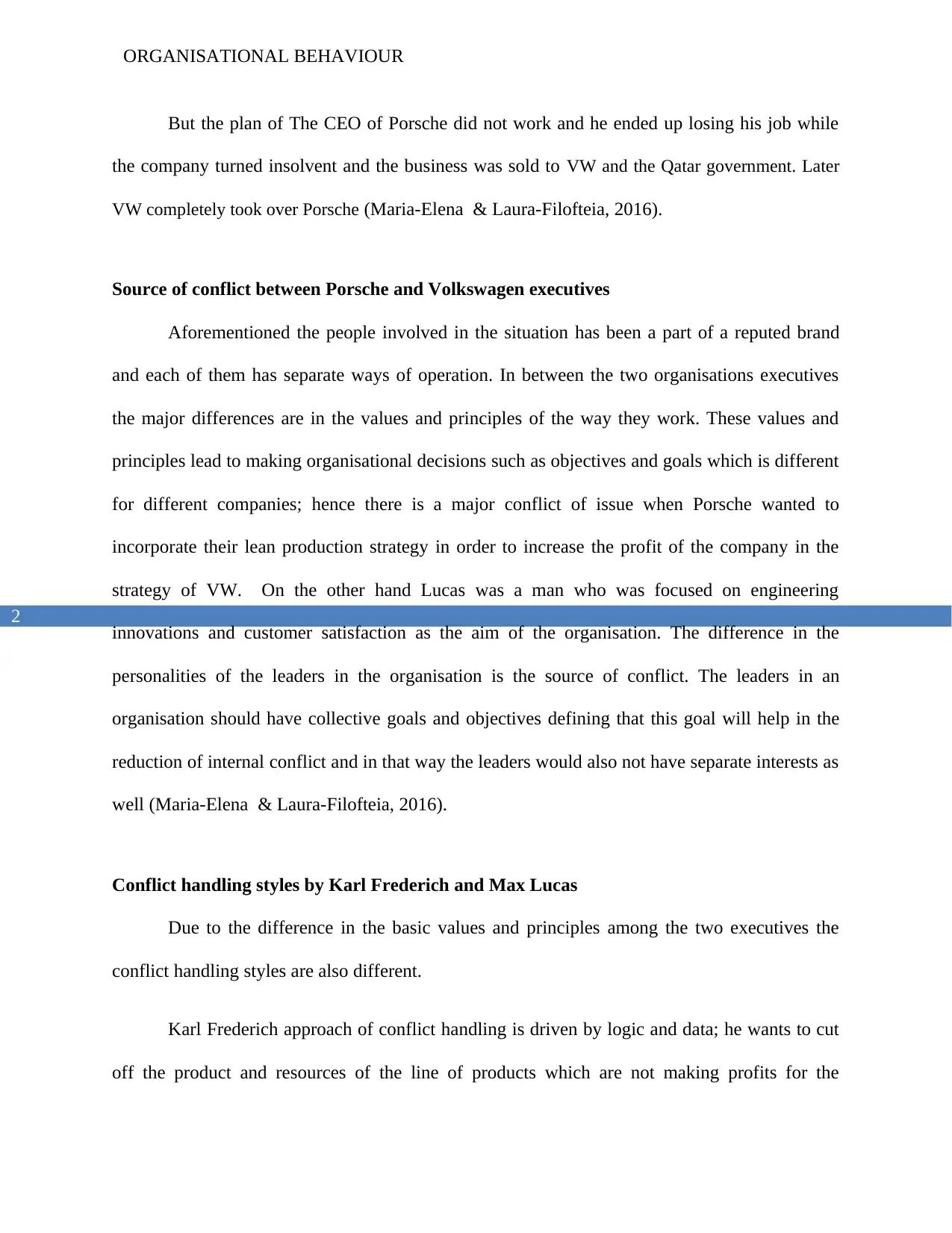
ORGANISATIONAL BEHAVIOUR
2
But the plan of The CEO of Porsche did not work and he ended up losing his job while
the company turned insolvent and the business was sold to VW and the Qatar government. Later
VW completely took over Porsche (Maria-Elena & Laura-Filofteia, 2016).
Source of conflict between Porsche and Volkswagen executives
Aforementioned the people involved in the situation has been a part of a reputed brand
and each of them has separate ways of operation. In between the two organisations executives
the major differences are in the values and principles of the way they work. These values and
principles lead to making organisational decisions such as objectives and goals which is different
for different companies; hence there is a major conflict of issue when Porsche wanted to
incorporate their lean production strategy in order to increase the profit of the company in the
strategy of VW. On the other hand Lucas was a man who was focused on engineering
innovations and customer satisfaction as the aim of the organisation. The difference in the
personalities of the leaders in the organisation is the source of conflict. The leaders in an
organisation should have collective goals and objectives defining that this goal will help in the
reduction of internal conflict and in that way the leaders would also not have separate interests as
well (Maria-Elena & Laura-Filofteia, 2016).
Conflict handling styles by Karl Frederich and Max Lucas
Due to the difference in the basic values and principles among the two executives the
conflict handling styles are also different.
Karl Frederich approach of conflict handling is driven by logic and data; he wants to cut
off the product and resources of the line of products which are not making profits for the
2
But the plan of The CEO of Porsche did not work and he ended up losing his job while
the company turned insolvent and the business was sold to VW and the Qatar government. Later
VW completely took over Porsche (Maria-Elena & Laura-Filofteia, 2016).
Source of conflict between Porsche and Volkswagen executives
Aforementioned the people involved in the situation has been a part of a reputed brand
and each of them has separate ways of operation. In between the two organisations executives
the major differences are in the values and principles of the way they work. These values and
principles lead to making organisational decisions such as objectives and goals which is different
for different companies; hence there is a major conflict of issue when Porsche wanted to
incorporate their lean production strategy in order to increase the profit of the company in the
strategy of VW. On the other hand Lucas was a man who was focused on engineering
innovations and customer satisfaction as the aim of the organisation. The difference in the
personalities of the leaders in the organisation is the source of conflict. The leaders in an
organisation should have collective goals and objectives defining that this goal will help in the
reduction of internal conflict and in that way the leaders would also not have separate interests as
well (Maria-Elena & Laura-Filofteia, 2016).
Conflict handling styles by Karl Frederich and Max Lucas
Due to the difference in the basic values and principles among the two executives the
conflict handling styles are also different.
Karl Frederich approach of conflict handling is driven by logic and data; he wants to cut
off the product and resources of the line of products which are not making profits for the
⊘ This is a preview!⊘
Do you want full access?
Subscribe today to unlock all pages.

Trusted by 1+ million students worldwide

ORGANISATIONAL BEHAVIOUR
3
organisation, this is logical as why would a company invest in items which is running at a loss.
His style is profit driven and is focused on the benefit of the organisation. Thus it can be said that
if the theory of conflict management by Kilmann & Thomas (1977), is considered the style that
has been adopted by Frederich is compromising in nature. This can be justified as he has not
tried to make the process of the failing lines better instead because it is non-profit making he
wants to shut those products down.
Max Lucas on the other hand is a person who is far sighted and looks in to management
as a larger picture. He follows the philosophy of marketing being art and science at the same
time. His conflict handling style is accommodating and collaborating in nature as explained by
Kilmann & Thomas (1977) in their conflict handling concept. He is an expert in the industry and
has worked with other automobile industry previously before taking his position as chairman of
VW. Therefore the combination of the two styles are justified, and his experience and his far
sighted nature makes him a person who is driven by innovation and technology (Riasi &
Asadzadeh, 2015).
Outcome of the conflict
The outcome did not go very well for the Porsche CEO Karl Frederich, as the plan did
not work and he ended up losing his job, the company ran into bankruptcy. The depression and
financial crisis was something that was unforeseen by him, he did not think of the strategy from a
broad perspective and also did not consider the dynamic nature of the external business
environment (Gupta, 2013). The financial crises that had hit the international market had driven
the Porsche company on the brink of bankruptcy. In this condition VW had managed to get a
pass from the controlling interest of Porsche. Not only that, Porsche also sold some of its shares
3
organisation, this is logical as why would a company invest in items which is running at a loss.
His style is profit driven and is focused on the benefit of the organisation. Thus it can be said that
if the theory of conflict management by Kilmann & Thomas (1977), is considered the style that
has been adopted by Frederich is compromising in nature. This can be justified as he has not
tried to make the process of the failing lines better instead because it is non-profit making he
wants to shut those products down.
Max Lucas on the other hand is a person who is far sighted and looks in to management
as a larger picture. He follows the philosophy of marketing being art and science at the same
time. His conflict handling style is accommodating and collaborating in nature as explained by
Kilmann & Thomas (1977) in their conflict handling concept. He is an expert in the industry and
has worked with other automobile industry previously before taking his position as chairman of
VW. Therefore the combination of the two styles are justified, and his experience and his far
sighted nature makes him a person who is driven by innovation and technology (Riasi &
Asadzadeh, 2015).
Outcome of the conflict
The outcome did not go very well for the Porsche CEO Karl Frederich, as the plan did
not work and he ended up losing his job, the company ran into bankruptcy. The depression and
financial crisis was something that was unforeseen by him, he did not think of the strategy from a
broad perspective and also did not consider the dynamic nature of the external business
environment (Gupta, 2013). The financial crises that had hit the international market had driven
the Porsche company on the brink of bankruptcy. In this condition VW had managed to get a
pass from the controlling interest of Porsche. Not only that, Porsche also sold some of its shares
Paraphrase This Document
Need a fresh take? Get an instant paraphrase of this document with our AI Paraphraser
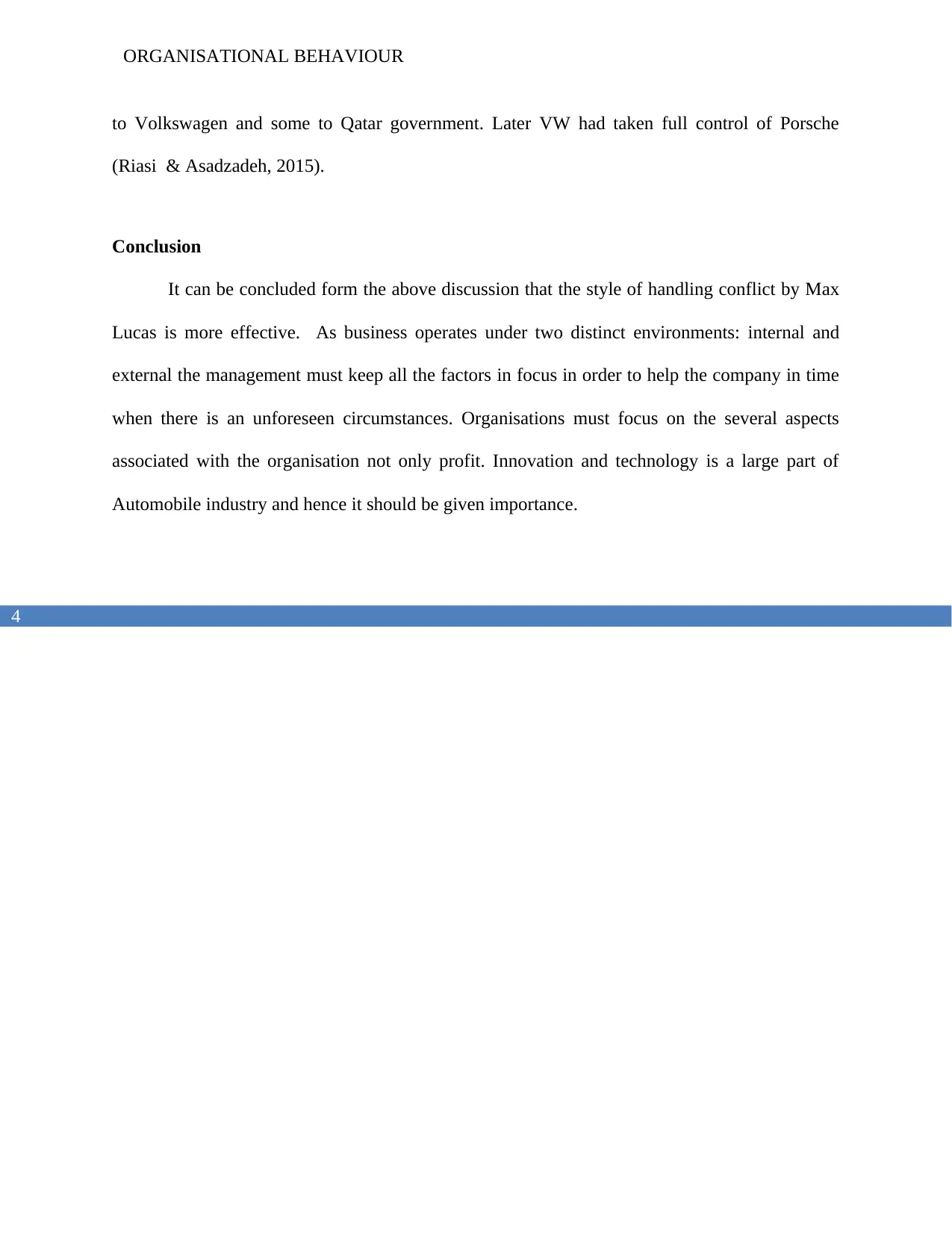
ORGANISATIONAL BEHAVIOUR
4
to Volkswagen and some to Qatar government. Later VW had taken full control of Porsche
(Riasi & Asadzadeh, 2015).
Conclusion
It can be concluded form the above discussion that the style of handling conflict by Max
Lucas is more effective. As business operates under two distinct environments: internal and
external the management must keep all the factors in focus in order to help the company in time
when there is an unforeseen circumstances. Organisations must focus on the several aspects
associated with the organisation not only profit. Innovation and technology is a large part of
Automobile industry and hence it should be given importance.
4
to Volkswagen and some to Qatar government. Later VW had taken full control of Porsche
(Riasi & Asadzadeh, 2015).
Conclusion
It can be concluded form the above discussion that the style of handling conflict by Max
Lucas is more effective. As business operates under two distinct environments: internal and
external the management must keep all the factors in focus in order to help the company in time
when there is an unforeseen circumstances. Organisations must focus on the several aspects
associated with the organisation not only profit. Innovation and technology is a large part of
Automobile industry and hence it should be given importance.
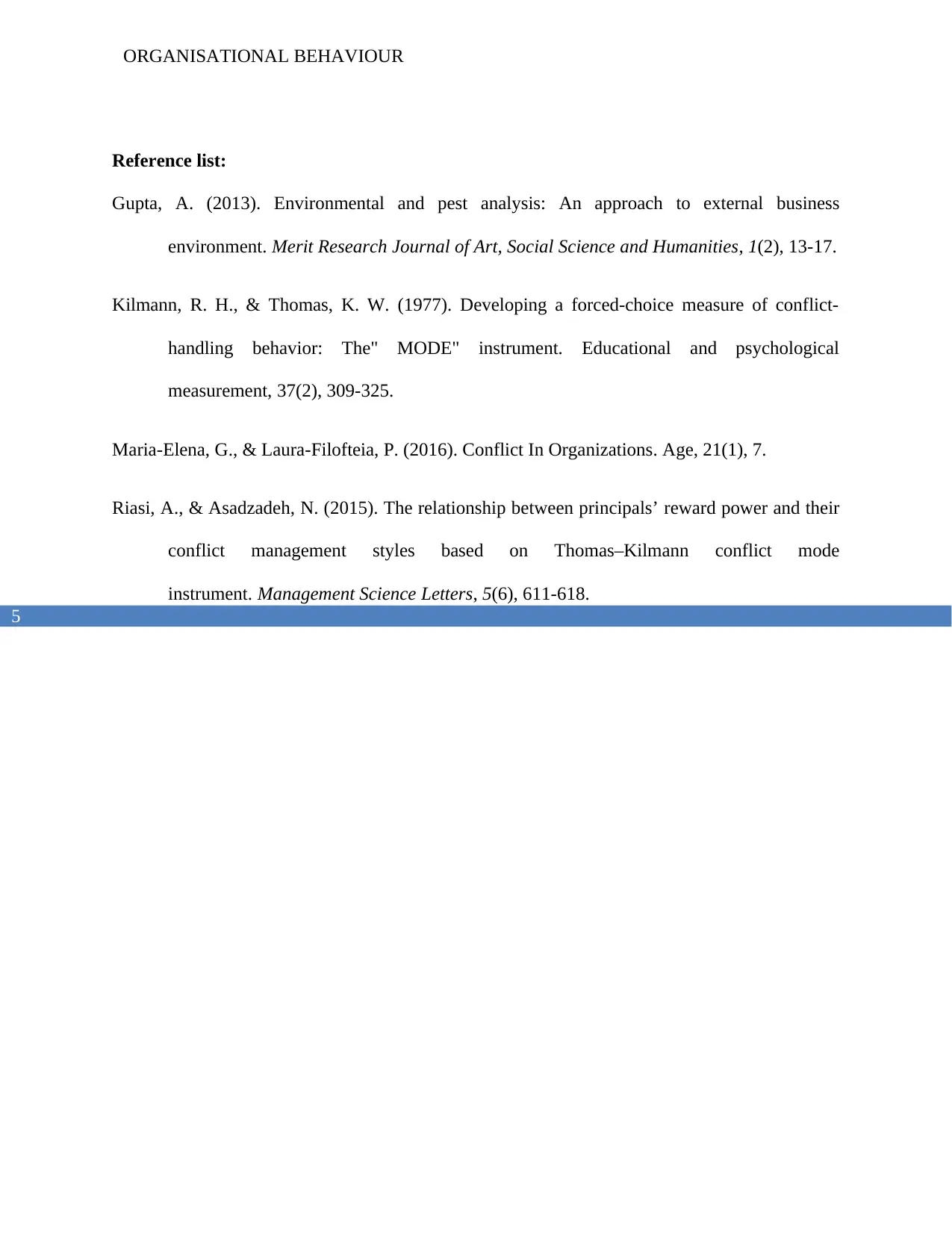
ORGANISATIONAL BEHAVIOUR
5
Reference list:
Gupta, A. (2013). Environmental and pest analysis: An approach to external business
environment. Merit Research Journal of Art, Social Science and Humanities, 1(2), 13-17.
Kilmann, R. H., & Thomas, K. W. (1977). Developing a forced-choice measure of conflict-
handling behavior: The" MODE" instrument. Educational and psychological
measurement, 37(2), 309-325.
Maria-Elena, G., & Laura-Filofteia, P. (2016). Conflict In Organizations. Age, 21(1), 7.
Riasi, A., & Asadzadeh, N. (2015). The relationship between principals’ reward power and their
conflict management styles based on Thomas–Kilmann conflict mode
instrument. Management Science Letters, 5(6), 611-618.
5
Reference list:
Gupta, A. (2013). Environmental and pest analysis: An approach to external business
environment. Merit Research Journal of Art, Social Science and Humanities, 1(2), 13-17.
Kilmann, R. H., & Thomas, K. W. (1977). Developing a forced-choice measure of conflict-
handling behavior: The" MODE" instrument. Educational and psychological
measurement, 37(2), 309-325.
Maria-Elena, G., & Laura-Filofteia, P. (2016). Conflict In Organizations. Age, 21(1), 7.
Riasi, A., & Asadzadeh, N. (2015). The relationship between principals’ reward power and their
conflict management styles based on Thomas–Kilmann conflict mode
instrument. Management Science Letters, 5(6), 611-618.
⊘ This is a preview!⊘
Do you want full access?
Subscribe today to unlock all pages.

Trusted by 1+ million students worldwide
1 out of 6
Related Documents
Your All-in-One AI-Powered Toolkit for Academic Success.
+13062052269
info@desklib.com
Available 24*7 on WhatsApp / Email
![[object Object]](/_next/static/media/star-bottom.7253800d.svg)
Unlock your academic potential
Copyright © 2020–2025 A2Z Services. All Rights Reserved. Developed and managed by ZUCOL.




